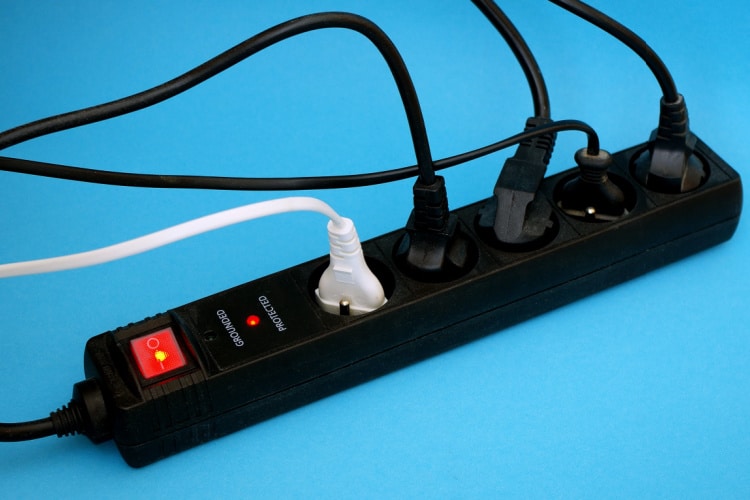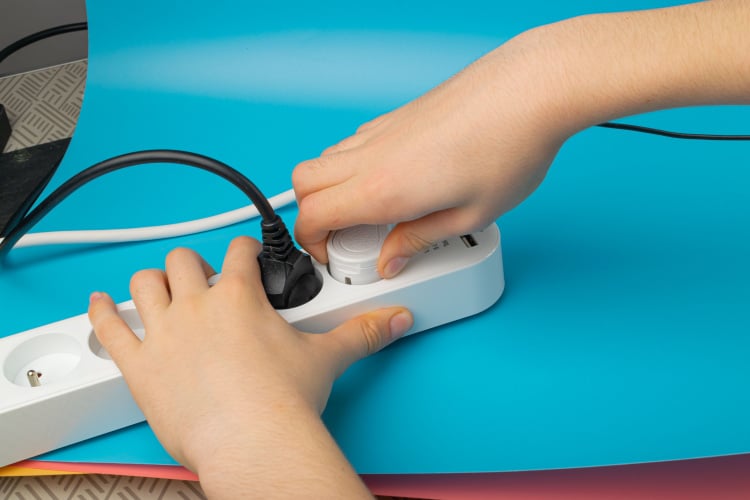The caution label on the box of surge protectors and extension cables reads, “Do not daisy-chain.” Yet, many people dismiss the warning, thinking: “What’s the worst that can happen?”
At first look, both devices appear to work in the same way. However, plugging a surge protector into an extension cord is against the safety rules specified by the Occupational Safety and Health Administration and National Fire Protection Association (NFPA).

So, no, the two devices are not supposed to be linked, and there are strong justifications behind this restriction. This article will teach you why plugging a surge protector into an extension cord is a bad idea. So, let’s jump right to it.
The Pitfalls of Plugging a Surge Protector Into an Extension Cord
When there aren’t enough outlets available, plugging a surge protector into an extension cable may seem like a great solution and a quick fix to our problem. However, we rarely think about the safety concerns or why the label states, “do not daisy-chain.”
So what is daisy-chaining, and why is it a violation of the Occupational Safety and Health Administration and National Fire Protection Association’s (NFPA) safety rules?
Daisy-chaining is the act of connecting multiple-socket adaptors and powering them from a single outlet. Unfortunately, despite the adorable childhood memories this expression might arouse, daisy-chaining poses a very serious fire hazard.
Extension cords and surge protectors are designed to handle from 15 to 20 amps of electricity which is 1,800 watts to 2,400 watts of power per outlet.
So when numerous devices are plugged into daisy-chained surge protectors and extension cords, the combined electricity consumption surpasses their wattage limits.
When the wattage limit is exceeded, the electrical wires overheat, and before you know it, fire may ensue.
At the same time, the fuses of surge protectors and extension cords will probably explode because they aren’t built to operate with such high wattage demand.
If the fuses don’t blow, which is frequently the case with poor-quality extension cables and surge protectors, the overload will affect the circuit. In such a scenario, the fuse will not activate, and the excessive amount of power drawn from the outlet will overload the circuit, eventually resulting in an electrical fire.
All these effects also apply when daisy-chaining a surge protector into another surge protector.
The Severity of an Electrical Fire
Electrical fires are difficult to put out, but it’s not difficult to understand why. Water conducts electricity, so conventional firefighting techniques would only worsen matters.
Because of this, most electrical flames need a particular type of extinguisher to put them out, known as a class C fire extinguisher.
What’s more, in the event of a fire, chances are plugged-in gadgets and appliances will become irreversibly damaged. And depending on the nearby materials, such as flammable liquids, gas, paper, and wooden interiors, the flames can spread rapidly and damage the house’s structural components.
Dodging Daisy-Chaining Hazards
Your first line of defense is the easiest – stop daisy-chaining surge protectors into power cords! There’s a good chance you don’t need all the plugged-in appliances running simultaneously. So, all you need to do is decide what can wait until later to use!
In work-related situations, thankfully, office and event spaces typically have more than enough outlets for the task. But, if not, upgrading a space or at least the impacted areas with more receptacles is the best and safest option.
If you use multi-plug surge protectors and extension cords, always buy the ones approved by OSHA’s Nationally Recognized Testing Center. Otherwise, you run the risk of electrical overload and fire. And even with high-quality surge protectors and extension cords, never daisy-chain them!
Can You Plug a Power Strip into an Extension Cord?
Another thing you should never do is plug a power strip into an extension cord. As we already discussed, connecting a surge protector to an extension cable could overload the circuit and start an electrical fire.
Power strips are similar to surge protectors, so the daisy chain rule applies to both. However, although similar, they aren’t the same, so be careful not to mix them up because if you do, you risk damaging your equipment.
What makes the difference between a power strip and a surge protector ? The purpose of a power strip is to increase the number of outlets accessible. In contrast, the purpose of a surge protector is to provide additional outlet space and shield devices from potential power surge damage.
Extension Cord, Surge Protector, and Power Strip Safety

Multi-plug equipment is ideal when we’re low on receptacles. However, we must use them carefully. According to the National Fire Protection Association (NFPA), improper usage of multi-plug tools is one of the main reasons for household electrical fires.
Daisy-chaining is one thing to avoid. Mistaking a surge protector for a power strip is another. To prevent a third mistake, you need to learn what types of appliances are and aren’t compatible with multi-plug tools.
Here’s what you can plug into an extension cord, power strip, or surge protector:
- Cell phone charger
- Laptop charger
- Coffee maker
- Tablet charger
- Table lamp
- Digital clock
- Modem
- Blender
- Toaster
- Printer
- Copier
- Gaming console
- PCs
- TVs
On the other hand, you shouldn’t plug the following devices and appliances into an extension cord, power strip, or surge protector:
- Outdoor appliances (a grill)
- Fridge
- Washing machine
- Dishwasher
- Air conditioner
- Hair dryer
- Garbage disposal
- Oven
- Freezer
- Space heater
Other Safety Tips for Using Extension Cords, Power Strips, and Surge Protectors
- Never use extension cords, power strips, and surge protectors with worn, burned, split, or gouged wires.
- Extension cords, power strips, and surge protectors are for temporary use. They shouldn’t be installed in a building’s framework or passed through holes in walls, windows, or doors.
- Eliminate the danger of physical harm. For example, never tuck power strips, surge protectors, or extension wires under mats, rugs, or sofas.
- If the power strips, surge protectors, or extension wires become hot, this could indicate the wire is being overwhelmed and is powering more equipment than it should.
Conclusion
Here’s where we conclude our “daisy-chain” discussion. And before we say goodbye, let’s quickly review the main takeaways.
A daisy chain is when multi-plug tools are connected to one another to provide more outlet space and reach all devices in an area.
Daisy-chaining is strongly prohibited by the Occupational Safety and Health Administration and National Fire Protection Association (NFPA) because it’s a technique that often results in an electrical fire.
Neither a surge protector nor a power strip should be plugged into an extension cord. The best-case scenario for when you need more outlet space is to temporarily unplug the devices you aren’t using and make room for the ones you need.
Even then, you need to be careful what types of devices you’re plugging because the power strip, surge protector, or extension cord can’t handle too high wattage consumption.
The safest option would be to plug devices with lightweight wattage. Anything from smartphone chargers to gaming consoles, TVs, and lamps, should be okay. On the other hand, kitchen appliances, space heaters, hair tools, etc., are high-wattage and should have their dedicated outlet.